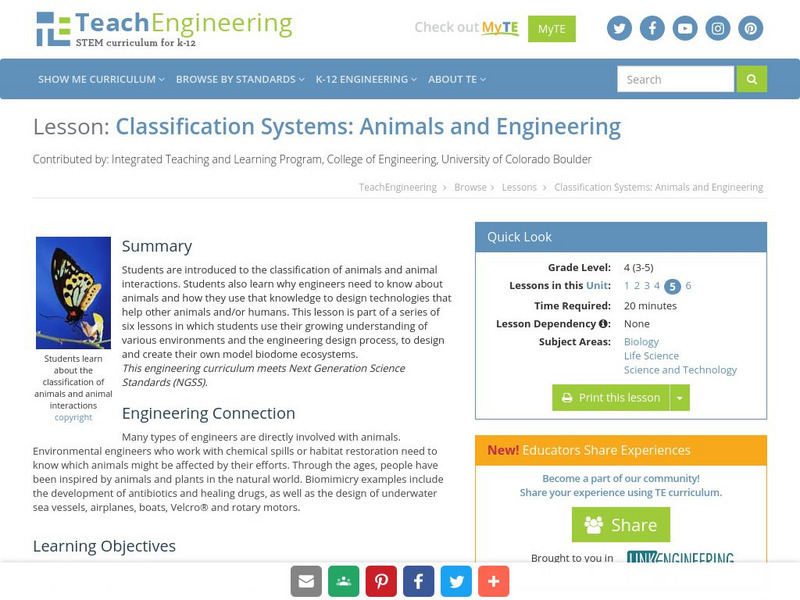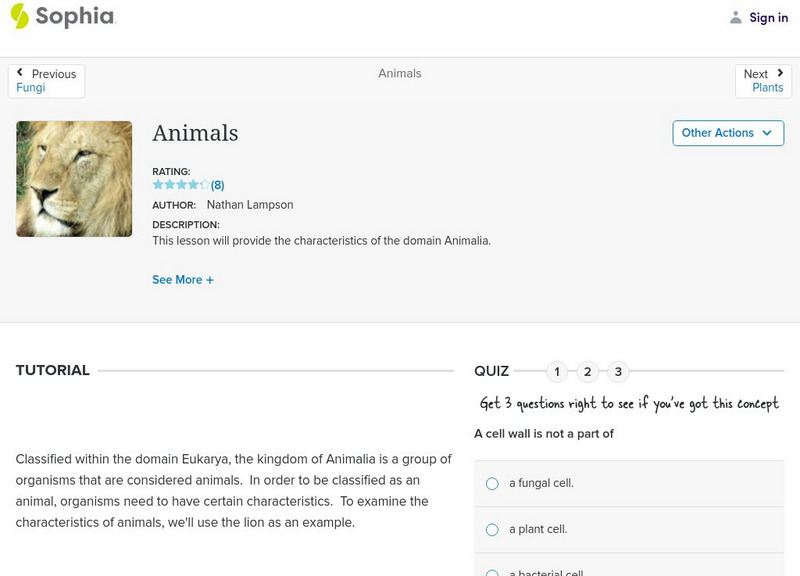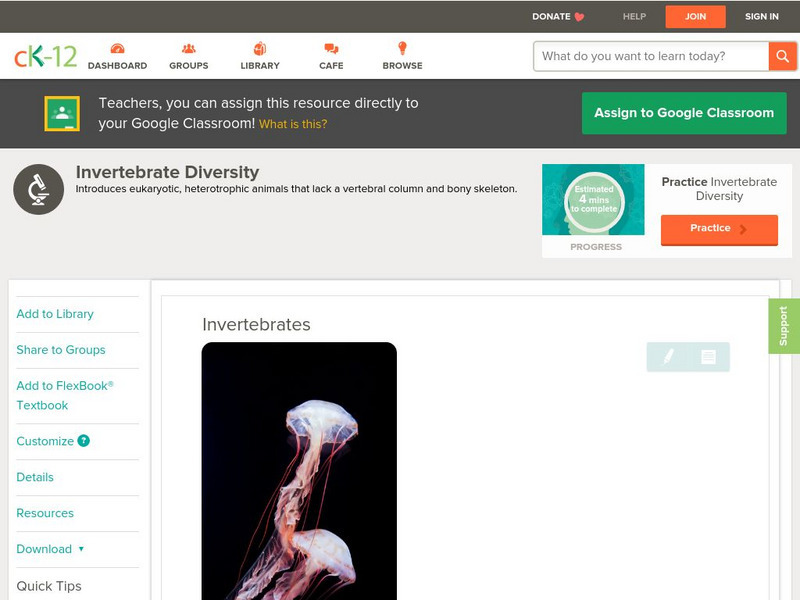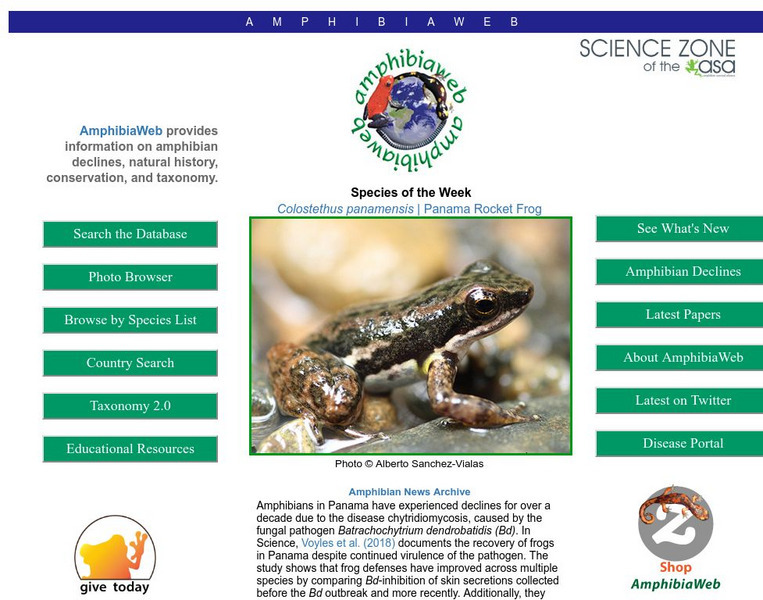Alabama Learning Exchange
Alex: Classification
This lesson will explain the reasons that society groups and classifies. The lesson has a hands-on component that helps learners connect everyday grouping with the way that scientists group and classify all living organisms.
Other
Illinois Wesleyan Univ.: Tardigrade Species Distribution Project: Lesson Plan
This lesson plan was for classes that participated in a research project on tardigrades that took place in 1999. Tardigrades, also known as water bears, are fascinating, tiny creatures that can survive under the most extreme conditions....
TED Talks
Ted: Ted Ed: The Evolution of Animal Genitalia
Genitals are the fastest-evolving organs in the animal kingdom. Menno Schilthuizen explains how the evolutionary biology of nature's nether regions uncovers a hidden world of seduction, conflict, and rivalry.
CK-12 Foundation
Ck 12: Biology: Animal Characteristics
[Free Registration/Login may be required to access all resource tools.] Overview of animals.
ArtsNow
Arts Now Learning: Magic Rocks [Pdf]
In this lesson, students work in groups with each acting as a predator, prey, or family member in a particular habitat. They present their habitat performance to the class and students identify the habitat and animal relationships. Then,...
TED Talks
Ted: Ted Ed: Inside the Ant Colony
Ants have one of the most complex social organizations in the animal kingdom; they live in structured colonies that contain different types of members who perform specific roles. Deborah M. Gordon explains the way these incredible...
TeachEngineering
Teach Engineering: Animals and Engineering
Students are introduced to the classification of animals and animal interactions. Students also learn why engineers need to know about animals and how they use that knowledge to design technologies that help other animals and/or humans....
HotChalk
Hot Chalk: Lesson Plans Page: Guess the Animal Using Animal Sounds
This learning game is designed to help young students distinguish the sounds that various animals make.
HotChalk
Hot Chalk: Lesson Plans Page: Animal Tic Tac Toe
This learning game is designed to help young students distinguish between insects, reptiles, and mammals.
ClassFlow
Class Flow: Egg Citing Adventures
[Free Registration/Login Required] Chickens aren't the only ones who lay eggs. Through poetry and hands-on activities, students learn how birds, reptiles, fish, and amphibians are alike and different. Number activities and videos are...
CK-12 Foundation
Ck 12: Life Science: Organization of Living Things
[Free Registration/Login may be required to access all resource tools.] When you see an organism that you have never seen before, you probably put it into a group without even thinking. If it is green and leafy, you probably call it a...
CK-12 Foundation
Ck 12: Life Science: 11.9 Organization of Living Things
Learn the system that scientists use to classify living things.
TeachEngineering
Teach Engineering: Biodomes
Students explore the biosphere's environments and ecosystems, learning along the way about the plants, animals, resources and natural cycles of our planet. Over the course of lessons 2-6, students use their growing understanding of...
TED Talks
Ted: Ted Ed: Why Isn't the World Covered in Poop?
Each day, the animal kingdom produces roughly enough poop to match the volume of water pouring over Victoria Falls. So why isn't the planet covered in the stuff?
ClassFlow
Class Flow: Classifying Invertebrates
[Free Registration/Login Required] This is a lesson on classifying invertebrates based on their observable features. It focuses on the three types of worms: flatworm, roundworm, and segmented worm. The lesson contains 3 videos as well as...
Read Works
Read Works: Classify and Categorize 2nd Grade Unit
[Free Registration/Login Required] A series of three lesson plans designed to teach students to classify and categorize items, characters, and information. The third lesson is based on the book Splish! Splash! Animal Baths by April...
Nature Conservancy
The Nature Conservancy: Gardens Activity Guide: Habitats
In this instructional activity students learn how the garden provides habitat for a variety of different animal species. They make observations and collect data to determine which species inhabit the garden. They will investigate...
Sophia Learning
Sophia: Animals
This lesson will provide the characteristics of the kingdom Animalia.
Alabama Learning Exchange
Alex: Diving Into the Dewey Decimal System
This lesson reinforces an introduction to the Dewey Decimal System to grades 3-5 with a game. Small competing groups locate books on the shelves. Groups are given a time limit to locate as many books from a numbered card stack as...
CK-12 Foundation
Ck 12: Life Science: Invertebrates
[Free Registration/Login may be required to access all resource tools.] Animals are also often identified as being either invertebrates or vertebrates. These are terms based on the skeletons of the animals. Vertebrates have a backbone...
ClassFlow
Class Flow: Vertebrates and Invertebrates
[Free Registration/Login Required] Using this lesson the students will review the 2 groups of animals - vertebrates and invertebrates. They will be actively involved in classifying animals. An Activote assessment is also included.
University of California
Regents of the University of California: Amphibia Web
AmphibiaWeb, a site inspired by global amphibian declines, is an online system that allows free access to information on amphibian biology and conservation. This site is filled with amphibian facts, a glossary of terms, species numbers,...
Other
K 3 Learning Pages: Reptiles and Amphibians
Come and discover more about reptiles and amphibians when you explore this awesome resource. This site is filled with useful links.






![Arts Now Learning: Magic Rocks [Pdf] Lesson Plan Arts Now Learning: Magic Rocks [Pdf] Lesson Plan](https://d15y2dacu3jp90.cloudfront.net/images/attachment_defaults/resource/large/FPO-knovation.png)














